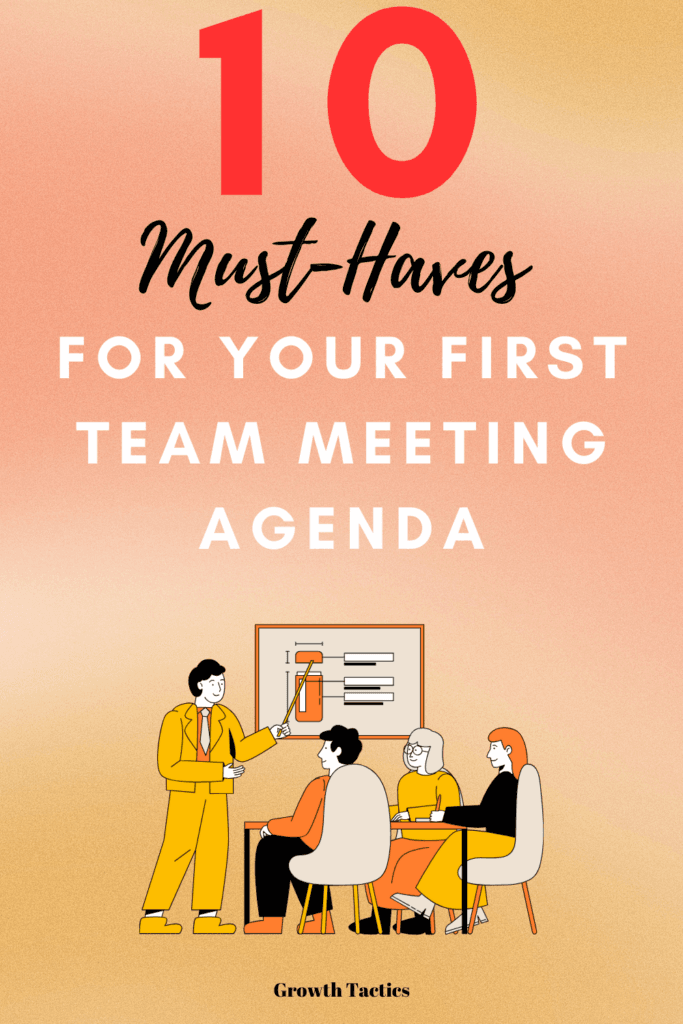As a new manager, your first team meeting sets the tone for future interactions and team dynamics. A well-structured agenda is crucial for making this initial gathering productive and engaging. Here are ten essential items to include in your first team meeting agenda to ensure you start on the right foot.
Jump To Section
What Should Be Included In Your First Team Meeting Agenda?
1. Icebreaker Activity
An effective icebreaker can set a positive tone for the entire meeting. Here are some expanded ideas:
- Two Truths and a Lie: Each person shares three statements about themselves, two true and one false. Others guess which is the lie.
- Speed Networking: Pair team members for quick 2-minute conversations, then rotate partners.
- Common Ground: In small groups, members find five things they all have in common.
- Would You Rather: Present amusing scenarios and have team members choose sides, explaining their choices.
- Show and Tell: Ask everyone to bring an object that represents them and share its significance.
Remember to keep the activity brief (5-10 minutes) and appropriate for your team’s size and culture.
2. Introduction and Welcome
Expand your introduction to include:
- Your leadership philosophy
- What drew you to this role
- Your initial impressions of the team and organization
- A personal anecdote that illustrates your values or approach
For team member introductions, consider a structured format:
- Name and role
- Professional background (brief)
- One professional goal for the year
- One personal fact or interest
Allocate about 1-2 minutes per person to keep things moving.
3. Team Vision and Goals
When presenting the team vision and goals:
- Start with the big picture: organization-wide objectives
- Narrow down to department-level goals
- Finally, focus on team-specific targets
For each goal, clearly state:
- The objective
- Why it’s important
- How it will be measured
- The timeline for achievement
Encourage discussion by asking:
- “How do you see your role contributing to these goals?”
- “What challenges do you foresee in achieving these objectives?”
- “What resources or support might we need to succeed?”
4. Roles and Responsibilities
To clarify roles effectively:
- Provide a visual org chart showing the team structure
- For each role, outline:
- Key responsibilities
- Decision-making authority
- Main collaborators within and outside the team
- Discuss how roles interact and depend on each other
- Address any recent or upcoming changes in roles
- Invite questions about role boundaries or overlaps
Consider a brief exercise where each person shares:
- Their understanding of their primary responsibilities
- One way they plan to support their teammates
5. Communication Expectations
Develop a comprehensive communication plan:
- Daily communication:
- Preferred tools (e.g., Slack, email, phone)
- Expected response times for urgent vs. non-urgent matters
- Regular meetings:
- Types (team meetings, one-on-ones, project check-ins)
- Frequency and duration
- Standard agendas or formats
- Reporting:
- Types of reports required
- Frequency and deadlines
- Preferred formats or templates
- Remote work considerations:
- Tools for virtual collaboration
- Expectations for video calls vs. audio-only
- Conflict resolution:
- Process for addressing interpersonal issues
- Escalation path for unresolved conflicts
Discuss and agree on communication norms, such as:
- When to use “Reply All” in emails
- How to indicate urgency in messages
- Protocol for after-hours communication
6. Team Norms and Values
Collaboratively establishing team norms and discussing core values is crucial for creating a cohesive and productive work environment, especially during the first meeting. Here’s how to approach this:
- Start with a brief explanation of why norms and values are important
- Present a draft of core values for discussion, such as:
- Integrity
- Innovation
- Collaboration
- Customer focus
- Continuous learning
For each value, discuss:
- What it means in practice
- How it aligns with organizational values
- Examples of how it might guide decision-making
Then, facilitate a discussion to establish team norms around:
- Punctuality:
- Meeting start and end times
- Deadlines for deliverables
- Meeting etiquette:
- Use of devices during meetings
- Speaking order or hand-raising protocols
- Preparation expectations
- Conflict resolution:
- Steps for addressing disagreements
- When and how to involve leadership
- Decision-making processes:
- Consensus vs. hierarchical decisions
- How to voice dissenting opinions respectfully
- Work-life balance:
- Expectations for after-hours availability
- Respecting time off and vacation
Encourage input from all team members to foster a sense of ownership. Consider using a collaborative tool like a shared document or virtual whiteboard to capture ideas in real time.
Conclude this section by summarizing agreed-upon norms and values, and discuss how they will be reinforced and revisited over time.
7. Current Projects Overview
Providing a brief overview of ongoing projects and priorities gives context to current work and helps new team members understand where to focus their efforts. Here’s how to structure this section:
- List major ongoing projects with brief descriptions
- For each project, cover:
- Project goals and expected outcomes
- Current status and upcoming milestones
- Key stakeholders and team members involved
- Any immediate challenges or roadblocks
Use visual aids like Gantt charts or Kanban boards to illustrate project timelines and dependencies.
Discuss how these projects align with the team and organizational goals mentioned earlier.
Allow time for questions about each project, particularly from newer team members who may need additional context.
8. Q&A Session
An open Q&A session demonstrates your commitment to transparency and helps build trust. Here’s how to make it effective:
- Allocate sufficient time (at least 15-20 minutes)
- Encourage questions on any topic related to the team or work
- Be prepared to address concerns honestly and openly
- If you don’t know an answer, commit to finding out and following up
- Consider having team members submit questions anonymously beforehand to encourage more candid inquiries
- Address both individual and team-wide concerns
- Use this opportunity to identify any areas that may need further clarification or discussion in future meetings
9. Team Building Exercise
Including a short team-building activity promotes collaboration and strengthens relationships. Here are some ideas:
- Problem-solving exercise: Present a hypothetical work challenge and have the team brainstorm solutions together
- Creative challenge: Give the team a creative task, like building the tallest tower out of office supplies
- Personality assessment: Use a tool like MBTI or DiSC to discuss communication styles and team dynamics
- Virtual escape room: For remote teams, consider an online team-building activity to support the team.
- Skillshare: Have team members teach each other a quick skill or share a productivity tip
Whichever activity you choose, make sure to debrief afterward, discussing what the team learned about working together.
10. Next Steps and Action Items
Concluding the meeting effectively sets the stage for future productivity. Here’s how to wrap up:
- Summarize key takeaways from each section of the meeting
- Assign action items, clearly stating:
- What needs to be done
- Who is responsible
- When it’s due
- Discuss any immediate next steps, such as:
- Follow-up meetings
- Required training or onboarding activities
- Upcoming team events or deadlines
- Reiterate your open-door policy and how team members can reach you with further questions or concerns
- Thank everyone for their participation and express your excitement about working together
Consider sending a follow-up email with a summary of the meeting, including all action items and key decisions, to ensure everyone is on the same page moving forward.
Tips for an Effective First Team Meeting
1. Prepare Thoroughly
- Create a detailed agenda and distribute it in advance
- Familiarize yourself with each team member’s background and role
- Prepare any necessary materials (presentations, handouts, etc.)
- Test technology if using virtual meeting tools
- Arrive early to set up the room or virtual space
2. Set the Right Tone
- Start on time to demonstrate respect for everyone’s schedule
- Begin with a warm, enthusiastic welcome
- Use inclusive language and body language
- Smile and maintain eye contact (or look at the camera in virtual meetings)
- Show genuine interest in each team member
3. Establish Clear Objectives
- Clearly state the purpose of the meeting at the outset
- Outline specific goals you hope to achieve by the end of the session
- Explain how this meeting fits into the broader context of team development
4. Encourage Participation
- Use icebreakers and team-building activities to promote interaction in the staff meeting.
- Call on individuals by name to share their thoughts
- Use open-ended questions to stimulate discussion
- Acknowledge and validate contributions from team members
- Create a safe space for sharing ideas and concerns
5. Practice Active Listening
- Give your full attention to whoever is speaking
- Use nonverbal cues (nodding, maintaining eye contact) to show engagement
- Paraphrase or summarize key points to ensure understanding
- Ask follow-up questions to delve deeper into important topics
6. Manage Time Effectively
- Stick to the agenda as much as possible
- Use a timer for each agenda item if necessary
- Be prepared to table less critical discussions for future meetings
- Leave buffer time for unexpected but important conversations
7. Address Potential Conflicts Proactively
- Acknowledge any known issues or challenges upfront
- Establish ground rules for respectful disagreement
- Encourage open dialogue about concerns or reservations
- Be prepared to mediate if tensions arise
8. Demonstrate Leadership
- Clearly articulate your vision for the team
- Show confidence in your ability to lead and in the team’s potential
- Be decisive when necessary, but also open to input
- Model the behavior and attitude you expect from team members
9. Use Visual Aids
- Incorporate slides, charts, or diagrams to illustrate key points
- Use a whiteboard or shared screen for collaborative brainstorming
- Provide handouts or digital resources for important information
10. Balance Structure and Flexibility
- Follow your agenda, but be willing to adjust if valuable discussions emerge
- Allow for spontaneous interactions and idea-sharing
- Be prepared to adapt your approach based on team dynamics
11. Foster Team Identity
- Highlight shared goals and values
- Emphasize the unique strengths of the team
- Begin developing a team “brand” or identity
- Discuss how the team fits into the larger organizational structure
12. Address Individual Concerns
- Allow time for one-on-one interactions before or after the meeting
- Be approachable and open to private conversations
- Follow up individually with team members who seemed hesitant or concerned
13. End on a Positive Note
- Summarize key decisions and action items
- Express confidence in the team’s ability to succeed
- Share your excitement about working together
- End with an inspiring quote or motivational message
14. Follow Up Promptly
- Send a recap email within 24 hours
- Include action items, responsibilities, and deadlines
- Provide any promised resources or information
- Schedule follow-up meetings or one-on-ones as needed
15. Seek Feedback
- Ask team members for their thoughts on the meeting format and content
- Be open to suggestions for improvement
- Use feedback to refine your approach for future meetings
Remember, your first team meeting sets the tone for future interactions. By implementing these tips, you’ll create a positive, productive environment that encourages collaboration, open communication, and team cohesion. Good luck with your meeting!


